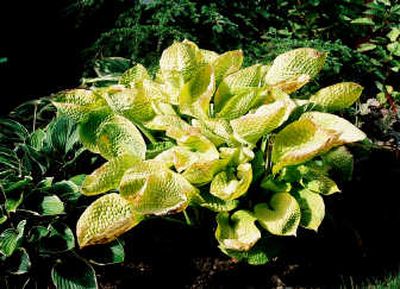Hostas introduce year-round color

Bright golden foliage glowing against a shady spot in the garden can make the landscape pop.
With the onset of autumn, gardeners should consider the merits of using perennials and shrubs with leaves that change with the season.
A well-planned four-season garden draws color from foliage at different heights as well as from seed heads and even bark.
Repeated throughout the garden, gold and yellow plants will draw the eye along the landscape and break up the sameness of green foliage. Plus, they offer a range of design options for blending with red, orange, lavender, purple or even more yellow.
Hostas are particularly useful since they come in so many sizes and shapes. A couple of my favorites are “Midas Touch” and “August Moon,” both of which transform from green to chartreuse to golden yellow as summer arrives. The color lingers through the first freeze.
These sun-tolerant hostas, and more with names like “Waffles” and “Sun Power,” turn golden yellow if they receive several hours of sun each day. Finding the right spot can be tricky since too much sun burns the leaves. Locations with late afternoon shade and a darker background are usually the best.
Most hostas, whether they are green, blue or variegated during the summer, will also turn yellow as they die back in the fall if conditions are favorable, meaning no early freeze.
When combined with trees and shrubs that have strong fall color, hostas will form a fall color foundation for an impressive form from top to bottom of the landscape.
This month’s Fine Gardening magazine lists several shrubs that bring autumn color to the middle levels of the garden. Among them are high-bush blueberry, witch hazel, chokeberry, spicebush, viburnum, oakleaf hydrangea, sumac and fothergilla. I would add deciduous azalea, winged euonymous (burning bush) and red-twig dogwood.
Different textures can be achieved when you add dwarf evergreens with gold or variegated yellow foliage, or small shrubs such as golden spirea or yellow variegated Japanese euonymous. Ornamental grasses add yet another dimension with their parchment tones and seed heads that persist through the winter.
One expert suggested planting asters near ornamental grasses because the colors and textures complement each other well. The pairing captures the warmth of September and early October without sacrificing the mellowness of autumn. Hardy chrysanthemums are widely available and worth the few dollars they cost. They can be planted in containers to create a seasonal look on the deck or porch.
Don’t forget that many smaller perennials such as some hardy geraniums, sedums and even some types of ferns will provide splashes of fall color along the borders.